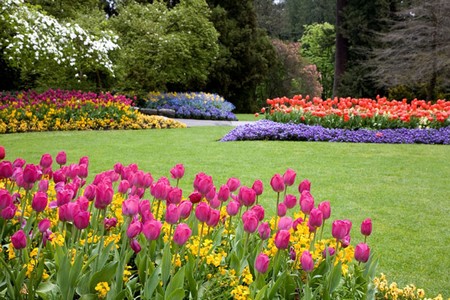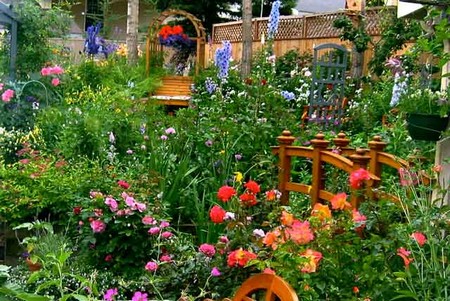To illustrate how I feel about the relative importance of form and color, visualize a bed of flowers in perfect color harmony, ranging perhaps from a palest pink to a deep violet, and planted exclusively with tall border phlox. They will all be of the same shape, with heavy trusses of flowers held at approximately the same height. The flowers and their colors are very beautiful but, to my mind, the picture is a little boring. Color has been taken care of, form neglected.
Now substitute for some of the phlox a few plants with flowers in spires. These could be Kansas gayfeather (Liatris spicata), say, or the tallest astilbe (Astilbe taquetii ‘Superba’)—in the same color harmony but now with contrast in form. The border comes alive and piques your interest.
Take another example, this one a border later on in the season. Here there is a mix of traditional seasonal colors, from cream and palest yellow, through gold, to a rich bronze. Picture this planted with varieties of coreopsis, black-eyed Susans, marigolds, and chrysanthemums. All are similar; they are bushlike in form and have flowers of daisy type. How much more interesting it would be to vary this, to have, for example, a late snakeroot (Cimicifuga simplex ‘The Pearl’), holding its white spires erect behind the compact, mounded black-eyed Susan (Rudbeckia fulgida ‘Goldsturm’), and Canadian burnet (Sanguisorba canadensis) rising behind the cushions of chrysanthemums.
I find almost any combination of spires and mounds irresistible. But these are far from being the only shapes to play against one another. Think of them as spires, and torches, spikes, wands; mounds and cushions; climbers and weavers; clouds and veils; mats and carpets; as canopies and umbrellas. All this, in plants that range from the diminutive Johnrty-jump-ups to a giant nine-foot angelica.
Granted, much of this is subliminal in effect, but it contributes to the total pleasurable experience. Our senses are able to take in so much more than we have words for, and every walk through the garden offers a gift to the senses.
And so we have come, at last, to what inspired you to make a garden in the first place—the flowers. Say what you will about all the other elements, flowers mean color. Even though plants are in leaf for a long season and in flower for only a small part of it, those flowers are the exquisite decorations of the border. After the carefully considered language used to evaluate plant form and leaf texture, sobriety flies out the window when we come to these miracles. Flowers like trumpets and bells, like goblets, pincushions, lockets, shells, and stars; flowers clustered into globes, candelabra, tassels, pagodas. And their colors!
When I stand before the border, one of these miracles in my hand, color, form, texture—all of this is in my mind. And then I know where I shall put it. “How very unscientific,” you say, “suppose I do that and it’s wrong—then what?” But you won’t get it wrong. You’re not in a world of right and wrong; you’re in your garden and all you’re looking for is your own ideal.
Categories
Advertisements
Recent Articles
 How to Understand Bed Sizes – A Small Guide
How to Understand Bed Sizes – A Small Guide How to Select Some Must Have Kitchen Accessories
How to Select Some Must Have Kitchen Accessories Best Way to Change a Car Tire
Best Way to Change a Car Tire Best Way to Write an Affirmation
Best Way to Write an Affirmation Best Way to Take Charge of Your Financial Life
Best Way to Take Charge of Your Financial Life Best Way to Survive a Party When You Don’t Know Anyone
Best Way to Survive a Party When You Don’t Know Anyone Best Way to Stop Self Sabotaging Yourself
Best Way to Stop Self Sabotaging Yourself Best Way to Start Journal Writing
Best Way to Start Journal Writing Best Way to Speak with a Powerful Voice
Best Way to Speak with a Powerful Voice Best Way to Simplify Your Life
Best Way to Simplify Your Life Best Way to Respond to a Put-Down
Best Way to Respond to a Put-Down Best Way to Reduce Acne Breakouts
Best Way to Reduce Acne Breakouts Best Way to Recover from Dining Disasters
Best Way to Recover from Dining Disasters Best Way to Quit Your Job Gracefully
Best Way to Quit Your Job Gracefully Best Way to Make Your Own Website
Best Way to Make Your Own Website



Leave a Reply